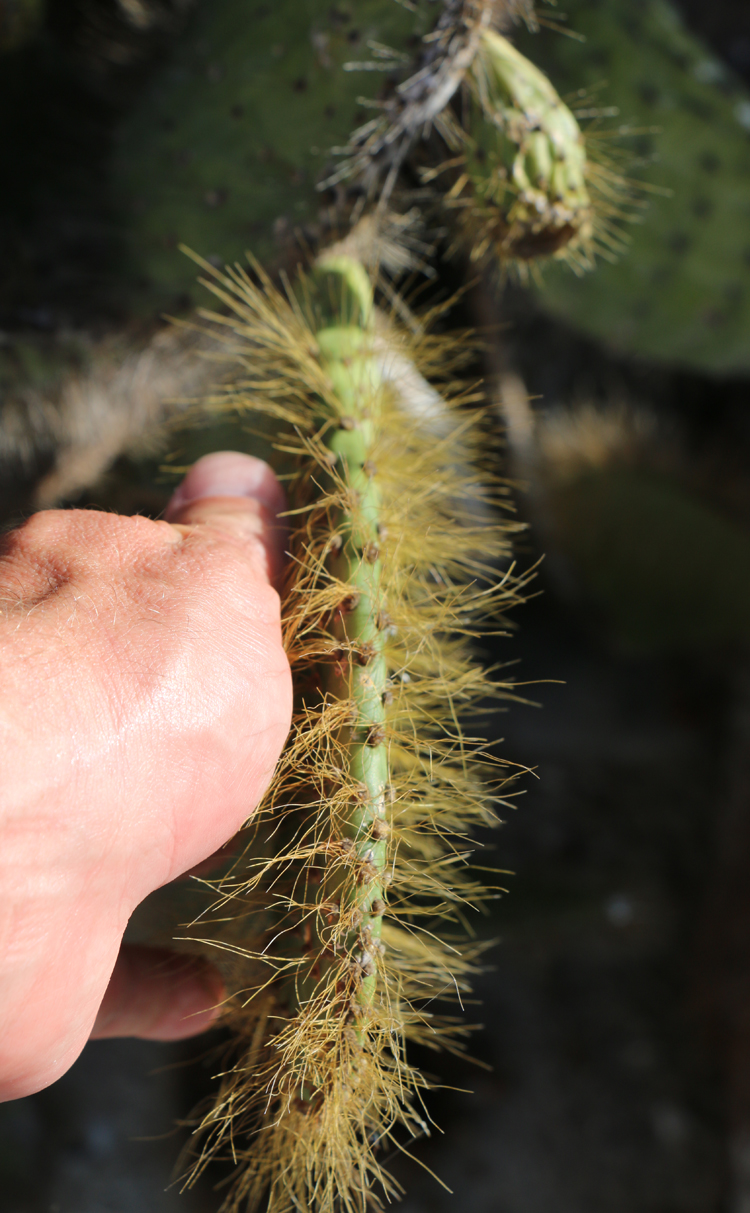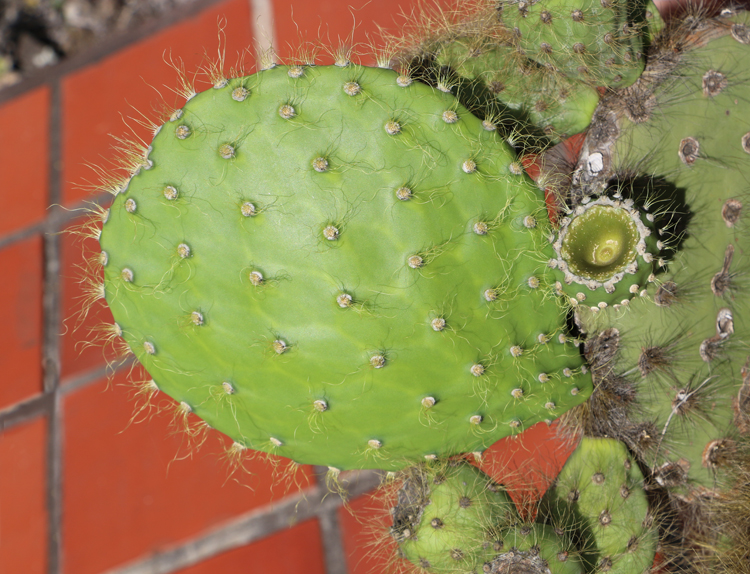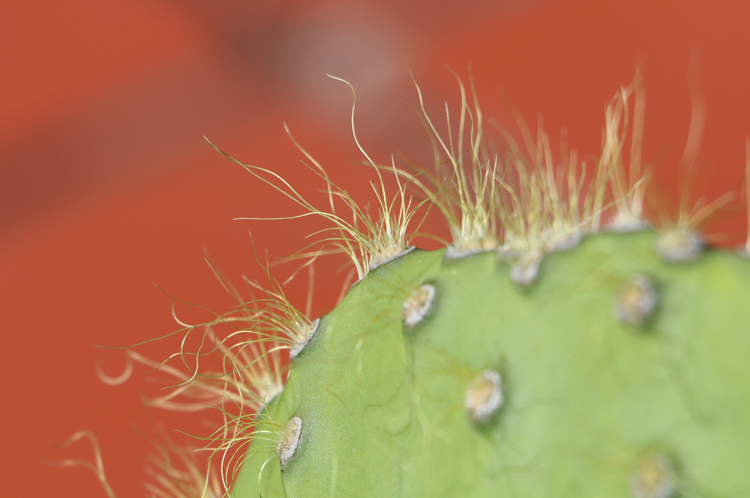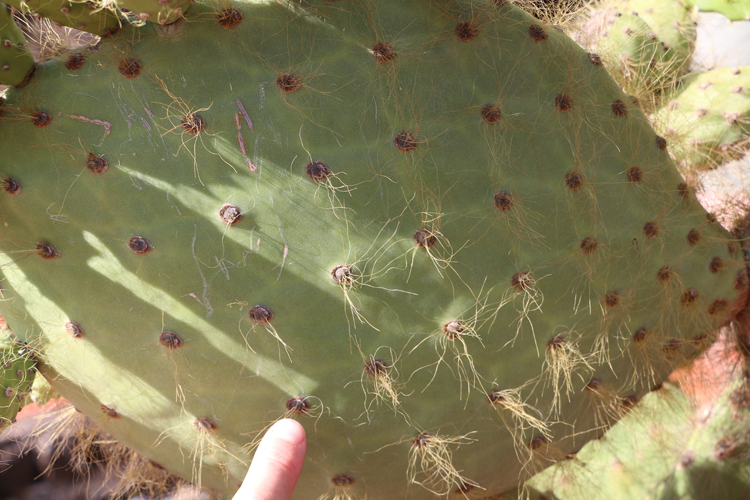15 January 2019
Easing of selective pressure on Opuntia cacti in the Galapagos Islands
Posted by Callan Bentley
As I mentioned yesterday, Galapagos land iguanas eat mainly the flesh and fruits of the Opuntia cacti that grow all over the dry lowlands of these islands.
As with most other cacti, the Galapagos Opuntia have spines to protect themselves from being munched by herbivores…
… Except where they don’t!
That’s right – In this video, you see my own defenseless hand, petting the cactus as if it were a cat!
Here’s a photo showing similar “cactus petting:”

Rather than being stiff and sharp and painful, these cacti have “spines” that behave more like hairs.


But doesn’t this leave the poor cactus defenseless against attack by vicious iguanas?
Yep! It sure does. …Good thing that doesn’t matter.
This is what happens when the cactus have a long time to grow and reproduce without being molested by vegetarian lizards.

On islands where land iguanas roam, cactus individuals are under strong selective pressure to have some sort of defense. Stiff spines are therefore essential for survival. Hungry, hungry lizards keep the pressure on the cacti to maintain strong defenses. On islands where the cactus grows and is never attacked by iguanas, however, that pressure is released. It’s no longer a “deal breaker” for survival if a mutation makes a cactus grow non-stiff spines. It doesn’t need spines any more, so it doesn’t matter. On iguanafied islands, spinelessness is a recipe for death. Dead iguanas don’t have babies. On noniguanified islands, spinelessness is either (a) fine and neither a good thing nor a bad thing or (b) maybe even a good thing, if making stiff spines is in some way energy or resource intensive — those resources are then freer to be reallocated elsewhere. All else being equal, the spineless, hairy cacti can survive, no problem! And that means they can reproduce, which means they can pass this trait on to their offspring.
Evolutionary prediction: if you were to release land iguanas on these “hairy cactus” islands, the iguanas would go to town on the defenseless cacti, strongly selecting against the “hairs-not-spines” trait. If there were a few individuals that still made stiff, sharp spines, they would be at a huge selective advantage. They would be selected as the survivors, and then would be eligible to go on and be the breeding stock that would be the foundation of the future cactus population on those newly-iguanified islands. The proportion of spines/hairs in the population would be predicted to increase.
It’s a neat trick to pet a cactus and not come away bleeding, but it’s also a nice prompt for a little lesson in how natural selection works.


 Callan Bentley is Associate Professor of Geology at Piedmont Virginia Community College in Charlottesville, Virginia. He is a Fellow of the Geological Society of America. For his work on this blog, the National Association of Geoscience Teachers recognized him with the James Shea Award. He has also won the Outstanding Faculty Award from the State Council on Higher Education in Virginia, and the Biggs Award for Excellence in Geoscience Teaching from the Geoscience Education Division of the Geological Society of America. In previous years, Callan served as a contributing editor at EARTH magazine, President of the Geological Society of Washington and President the Geo2YC division of NAGT.
Callan Bentley is Associate Professor of Geology at Piedmont Virginia Community College in Charlottesville, Virginia. He is a Fellow of the Geological Society of America. For his work on this blog, the National Association of Geoscience Teachers recognized him with the James Shea Award. He has also won the Outstanding Faculty Award from the State Council on Higher Education in Virginia, and the Biggs Award for Excellence in Geoscience Teaching from the Geoscience Education Division of the Geological Society of America. In previous years, Callan served as a contributing editor at EARTH magazine, President of the Geological Society of Washington and President the Geo2YC division of NAGT.
When discussing the changes in cacti needles and how natural selection works we have to remember that on the same island with soft needles cacti there are a lot of cacti with hard needles as well. It means that not all cacti changed their needles in the absence of herbivores.
This situation could bring many questions like why cacti needs soft needles at all?
If they don’t protect cacti, should cacti get rid of them altogether?
Also, it is important to know how the needle softening process works – we had never seen any cacti with half-soft needles. Does it mean that random mutations of genes only change needles between full hard and full soft conditions without any intermediary state?
Could it be that instead of natural selection, due to random mutation of some genes one lucky cactus got soft needles and was able to survive and multiply meanwhile passing its new soft needle feature to its descendants?
Actually, eating cacti fruits by iguanas could be beneficial for cacti. The seeds in the fruits could be spread by the iguanas or birds all over the islands. This is how it works in case of wild apples, cherries, plums and other fruit trees. They DO NOT grow any needles to protect their fruits – they are happy that their seeds are spread out all over the forest, much further than wind could do.
I am also concerned with low predictive power of natural selection theory. It sounds like it only explains what already happened so called post factum , but cannot predict what is going to happen. Could we predict that cacti needles will soften based on natural selection theory? I doubt it.
In thousands of gardens all over the globe roses still keep their thorns while there is no any predators to fight off. Roses are cultivated by humans for thousand years and they still have thorns without any predators. Yes, there are thorn-less roses, but actually there are very few of them and they are not easily producible. It looks that sometimes the nature is very stubborn and wants to keep particular features no matter what.
There are endless number of similar examples and they demonstrate weaknesses of natural selection theory. Therefore we have to be careful when we use it in our explanations.
Hi Jacob,
This is a very long comment you’ve left. It has many parts. My responses below:
Right – that’s the point of this post. They don’t need them, so due to the “easing up” of the otherwise strong selective pressure for protection, they are not maintained.
Sure – but “should” implies intentionality. The cactus isn’t making a decision here. It’s not planning ahead. That suggests a misconception of how natural selection works.
It’s not a “needle-softening” process. The soft needles are a trait, doubtless coded for by an allele (gene variant) or multiple alleles. I observed other cacti on the same island where these photos were taken that had intermediate stiffness spines. Furthermore, the “horse hair” spines I feature images and discussion of here are not “as soft as they could possibly get.” These in fact could be pecreived as “intermediate” between “as hard as they could possibly be” and “as soft and supple as they could possibly be,” or even “nonexistent.”
You have, in fact, just described natural selection as it applies to this example.
I’m not arguing against it being in the cactus’s interest to have its seeds dispersed. But it can’t make seeds if it cannot engage in photosynthesis due to all its flesh being eaten. The one is a pre-requisite for the other. I don’t have specific knowledge of whether Opuntia cactus seeds survive iguana digestion or not, mind you, but what you propose is neither implausible nor does it negate the value of protective armor (spines) when there is a predator about.
I believe I address this in the post, but absolutely natural selection makes predictions. It’s impossible to predict the random mutations that yield the raw material for diversity in the gene pool, but once that diversity is established, then it is relatively straightforward to predict that some variants may be more likely to survive than others, given a local set of environmental circumstances. Another Galapagos example: the large ground finch has a large beak that it uses for cracking open large seeds. In dry years in the Galapagos, the plants produce fewer seeds. We would predict that the large ground finches with more robust beaks (thicker beaks) would be more likely to survive. In a time of limited food, they can manage to access the nutrition in those big seeds – food that would be off limits to more petite large ground finches. They are able to keep their bellies full when weaker-beaked individuals are more likely to starve to death. This is precisely what Peter and Rosemary Grant found in their decades-long study of the Galapagos finches. Not only was the idea capable of generating a prediction, that prediction was verified through empirical study.
You should come to my yard and see what the deer do to my poor rose bushes, in spite of their thorns! 🙂
Seriously, though: Even in a deer-proof garden, the circumstances that allow the cactus the flexibility of “lowering its defenses” are not necessarily identical to those of the rose “lowering its defenses.” Cactus plants and rose plants are built from different genomes, and make different enzymes, and the variations that emerged in one lineage are not guaranteed to have emerged in the other. There is a strong role for contingency (random events) to play in generating the mutations that manifest as different traits. Your rose example may indicate that either the situation is not identical to the cactus, and because of this poor match, therefore not relevant as a counterexample. Or your rose example may indicate that there is in fact a strong selective pressure still operating on roses that make thorns worth having.
Are they all as easily rebutted as this one? 🙂